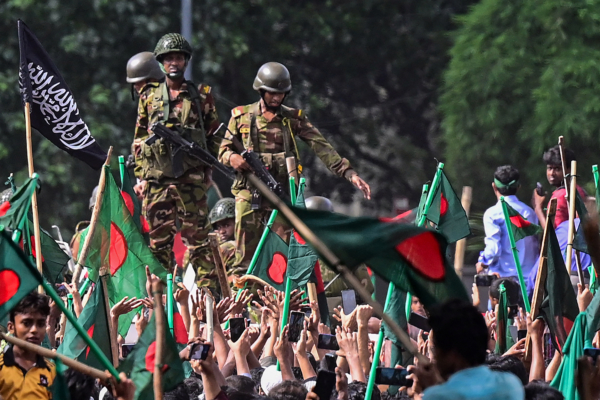Bangladesh’s Prime Minister, Sheikh Hasina, resigned and fled the country on Monday, August 5th, as Bangladesh experienced one of the most severe series of violent conflicts in its history, with hundreds losing their lives and thousands getting injured.
Army Chief of Staff, Waker-Uz-Zaman, made a televised address to the nation on Monday, announcing Hasina’s resignation and the formation of an interim government.
The 76-year-old Hasina reportedly flew to India on a military helicopter accompanied by her sister. According to CNN, she landed in Agartala, the capital of Tripura state in northeast India, across the eastern border of Bangladesh.
The Epoch Times was unable to immediately verify these reports.
Last month, what began as student protests against government civil service quotas escalated into a movement demanding Hasina’s removal.
On Sunday, nationwide deadly clashes erupted once again, resulting in at least 91 fatalities, including 13 police officers, and dozens injured.
Hasina secured her fourth consecutive term in January’s election, but the opposition Bangladesh Nationalist Party boycotted the polls.
General Zaman stated that he had held “fruitful” talks with “invited” major party leaders and would soon meet with President Mohammed Shahabuddin to discuss the country’s future path.
Retuers reported that Zaman, aged 58, took over as Army Chief of Staff on June 23, stressing, “The country is going through a period of drastic change.”
“I promise to seek justice for all those who have been murdered and treated unfairly. Please trust our country’s military,” he said. “I will take full responsibility and ensure that you are not disappointed.”
Last month, protests sparked by student organizations opposing the government’s job quota system led to violent incidents, claiming at least 150 lives and injuring thousands. On Monday, despite a nationwide curfew, protesting students urged marches towards the capital, Dhaka, demanding Hasina’s resignation.
“I urge everyone to be patient and give us some time; together, we will solve all problems,” Zaman said. “Let’s not resort to violence again; let’s return to the path of nonviolence and peace together.”
Television footage showed tens of thousands flooding the streets of Dhaka, expressing jubilation. Similarly, crowds numbering in the thousands headed towards Ganabhaban, Hasina’s official residence, chanting slogans, raising fists, and making victorious gestures.
Suddenly, Hasina’s residence was packed with people; some were seen carrying away televisions, chairs, and tables…
Someone shouted, “She has fled, she has fled.”
Videos showed protesters in Dhaka climbing onto a large statue of Hasina’s father, independence leader Sheikh Mujibur Rahman, and hacking at the statue’s head with an axe.
The death toll of at least 91 on Sunday marked the highest single-day death toll in Bangladesh’s modern history of protest activities, surpassing the 67 deaths during the July 19 student protests against quotas.
The government announced an indefinite nationwide curfew from 6 p.m. on Sunday (12 p.m. Greenwich Mean Time) and implemented a three-day national public holiday starting Monday.
Bangladesh Railway decided to indefinitely suspend all railway services due to escalating violence.
Some clothing factories servicing top global brands in the country have also ceased operations indefinitely.
Hasina’s critics and human rights organizations have accused her government of using excessive force against protesters, a claim denied by her and her ministers.
Hasina once stated, “Those perpetrating violence are not students, but terrorists; their aim is to disrupt national stability.”
The role of the country’s military in addressing the domestic violence issue has drawn attention, with a group of retired military officers calling for Hasina to withdraw troops from the streets and resolve the current crisis through political means.

